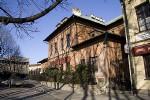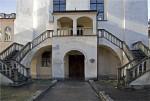Kazimierz route is connected with the history of Jewish settlers from the 15th century and it leads past the historic places of an exceptional importance.

Krakow is a place where the history of Jewish nation is still cherished. The biggest number of the historic places connected with the life of Jews in Krakow is located south of the Old Town – in Krakow Kazimierz and in Podgórze on the other bank of the river. Kazimierz route is connected with the history of Jewish settlers from the 15th century and it leads past the historic places of an exceptional importance. During sightseeing you should pay attention to a specific atmosphere of tolerance and co-existence of remnants of Jewish and Christian culture.
Remuh Synagogue and cemetery
We start our route from Szeroka St. – still being a central place of the Jewish Kazimierz. In the past there used to be even four synagogues, what made this place particularly valuable and important on the map of contemporary Krakow. In the number 40 we can see the Remuh synagogue, the smallest of Krakow temples, which was built in years 1556-1558 and still plays its sacral roles. Together with adjacent kirkut (Jewish cemetery) they are named after a scholar, Moses Isserles "Remu", whose grave, as a miracle worker’s grave, is visited every year by thousands of believers from around the world. A fenced square in front of the Remuh Synagogue is a common grave of a couple and wedding guests who died continuing reception despite the starting sabbath. Here you can also see a monument devoted to 65,000 of Krakow Jews who died during Holocaust.
Great Mykwa and Helena Rubinstein’s House
Building number 6 in Szeroka Street is an old Great Mikvah – the ritual bath for women and men built in 16th century. Nearby, marked with number 14, is a house of the famous Helena Rubinstein – later millionaire, known worldwide as the "Queen of the cosmetics", the owner of cosmetic laboratories.
Popper’s Synagogue
Further on the left we pass the building of the Popper’s Synagogue (Szeroka 16), in which currently the seat of the Old Town Centre of Youth Culture is placed. In the place of a building no. 22 next synagogue used to be situated – so called Synagogue on the Hill, connected with the person of a famous rabbi Natan Spira, whose memory is to be called up by the candle burning in the attic window of the current building.
Old Synagogue

On the south side of Szeroka Street the Old Synagogue is located. This is the oldest surviving synagogue in Poland, built in the beginning of the 15thcentury. It was repeatedly rebuilt and currently it is used by the Historical Museum of the City of Krakow, which prepared there the exhibition called "History and culture of the Jews of Krakow”.
Galicja Museum
Following further the Jewish trail around Kazimierz we head towards Dajwór Street. It is here, in the building number 18, where in 2004 Galicja Museum was established. It presents the exhibition entitled “Traces of Memory”, documenting the traces of Jewish past which remains present till now in the southern Poland.
High Synagogue
After leaving the museum we go towards the Św. Wawrzyńca St. which used to be the south border of the Jewish town. We turn right into Wąska Street and we reach Józefa Street. Here in a number 38 we reach next synagogue – so called High one. It was built in the later half of the 16th century. Rich, as sources inform, furnishing of the synagogue was stolen during the Swedish Deluge and also during the Second World War. Remarkable is the building’s architecture with high buttresses and richly sculpted late-renaissance portal.
Józefa Street which we follow is a road were a lot of galleries, antique shops and cosy cafes found their place. In the place of current crossing with Jakuba Street there was an entrance gate to the Jewish town separated from the Christian Kazimierz with fences and a stone wall. Going further it is worthwhile entering the gate of the building Józefa 12 – it is a passage joining Józefa and Meiselsa Streets, a really picturesque place, with characteristic architecture.
Centre of the Jewish Culture
In Meiselsa Street we turn right going past the building of the Centre of the Jewish Culture. Till the outbreak of the Second World War there was a prayer house, then it was turned into carpenter’s shop and now the lectures, author’s meetings, book promotions, concerts and exhibitions take place there.
New Square
In front of us there is a New Square – also called Jewish, with a characteristic shape of a round building ("okrąglak") – a trade hall, which earlier was a ritual poultry slaughterhouse. New Square during the day reverberates with the noise of trading people and at night with the sound coming from surrounding cafes, pubs and music clubs.
Izaak Synagogue

Leaving New Square along Izaaka Street we reach Izaak Synagogue (corner of Kupa and Izaaka Streets), which is the biggest synagogue of Kazimierz, and in the past was also considered to be the most beautiful and the richest.
Kupa Synagogue
A bit further, in Warszauera St. 8 there is a building of next synagogue - Kupa. Its name comes from a Hebrew word meaning common money of the Kahal (Jewish Community). Interior of Kupa Synagogue was completely destroyed during the war and was restored no sooner than in years 2000-2001 and since then it is used as a place of meetings, concerts and lectures. You can also see an exhibition of photographs devoted to Jews saved by Oskar Schindler.
Talmud Tora and Progressive Synagogue Tempel
Next important landmark of our route is the building of a former religious school of Talmud Tora, active from 1813 and situated on the corner of Warszauera and Estery Streets. When we follow Estery Street we reach the crossing of Miodowa and Podbrzezie Streets (Miodowa St. 24), where we find the newest of Kazimierz synagogues – the Progressive Synagogue Tempel.
Handcraft Bursa, School of the Handcraft and Hebrew Lower Secondary School
In Podbrzezie Street which runs behind the synagogue there are three objects connected with functionality of the Jewish town. Those are: the Handcraft Bursa (no. 6), the Upper Secondary School of the Handcraft of the Jewish Society of Public and Secondary School (no. 3) and the Hebrew Lower Secondary School (no. 8-10).
Hebrew Primary School and Salomon Daiches’s House of Prayer
In Brzozowa St., along which we return to Remuh cemetery and Szeroka Street, with a number 5 there used to be also Hebrew Primary School, and a building no. 6 is Salomon’s Daiches’s House of Prayer built in 1910.
New Jewish Cemetery
At this point of our tour we return to the place where we started but it is worth going to Miodowa Street 55 (on the opposite side of Starowiślna Street) to visit so called New Jewish Cemetery – burial place for the most notable Jews of Krakow living after the year of 1800.
Kazimierz is a place where the Jewish and Christian cultures permeated each other. A perfect possibility to experience that co-existence will be a walk along the route presenting Christian heritage of Kazimierz.
Author: Marcin Rybski
Edited by: Marcin Białota
License: Creative Commons - Non Commercial
